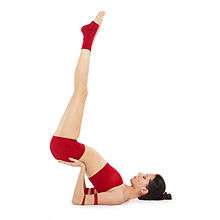Viparita Karani

Viparita Karani (Sanskrit: विपरीतकरणी ; IAST: viparītakaraṇī) literally Upside-Down is considered alternately as an asana or a mudra in haṭha yoga.
Etymology
The name comes from the Sanskrit words viparita meaning "inverted" or "reversed", and karani meaning "doing" or "making"[1] and asana (आसन; āsana) meaning "posture" or "seat".[2]
Description
Viparita Karani refers to any practice where one is upside down. This can include the asanas of shoulder stand (sarvangasana), headstand (sirsasana), or handstand (adho mukha vrksasana). In the hatha yoga pradipika, as in most classical texts on haṭha yoga , viparita karani is listed as a mudra (HYP III.7), meaning its purpose is for the directing of energy or kundalini upwards within the body (HYP III.5) as opposed to asanas which are used in the Hatha Yoga Pradipika to create steadiness (HYP I.19).
In one popular expression of viparita karani as an asana in modern postural yoga, it resembles Salamba Sarvāngāsana (supported shoulder stand) but with flexion in the thoracic spine (rather than the cervical spine, elbows on the floor and hands supporting hips or lower back.[3]
Variations include bringing the soles of the feet together such as in Baddha Konasana or letting the legs fall outward into a straddle.
See also
References
- ↑ "Witold Fitz-Simon - Viparita Karani". Retrieved 2011-07-29.
- ↑ Sinha, S.C. (1 June 1996). Dictionary of Philosophy. Anmol Publications PVT. LTD. p. 18. ISBN 978-81-7041-293-9. Retrieved 9 April 2011.
- ↑ "Viparita Karani Mudra (Upside Down Seal)". Yoga Art and Science. Retrieved 21 August 2012.
Further reading
- Iyengar, B. K. S. (1 October 2005). Illustrated Light On Yoga. HarperCollins. ISBN 978-81-7223-606-9. Retrieved 9 April 2011.
- Saraswati, Swami Janakananda (1 February 1992). Yoga, Tantra and Meditation in Daily Life. Weiser Books. ISBN 978-0-87728-768-1. Retrieved 11 April 2011.
- Saraswati, Swami Satyananda (1 August 2003). Asana Pranayama Mudra Bandha. Nesma Books India. ISBN 978-81-86336-14-4. Retrieved 9 April 2011.
- Saraswati, Swami Satyananda (January 2004). A Systematic Course in the Ancient Tantric Techniques of Yoga and Kriya. Nesma Books India. ISBN 978-81-85787-08-4. Retrieved 9 April 2011.